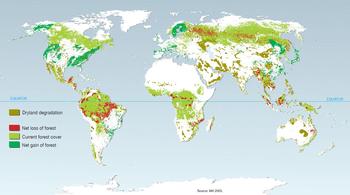Deforestation
Deforestation is the transformation of forested areas into non-forest land use such as arable land, urban use, logged area or wasteland. According to the United Nations Framework Convention on Climate Change (UNFCCC 2007) the main causes for deforestation are subsistence farming (42%), commercial farming (32%), legal as well as illegal wood extraction (logging)(14%) and fuel-wood (11 %). Right now forests still cover about 30% of the land area on our planet. However, as a modern-day plague the forest area in the world is still decreasing by the size of panama each year. (National Geographic 2016) With all the consequence listed under impacts of deforestation.
New results of the global forest area indicated that total forest area declined by 3%, from 4128M ha in 1990 to 3999 M ha in 2015. The annual rate of net forest loss halved from 7.3 M ha/y in the 1990s to 3.3 M ha/y between 2010 and 2015. Natural forest area declined from 3961 M ha to 3721 M ha between 1990 and 2015, while planted forest (including rubber plantations) increased from 168 M ha to 278 M ha. From 2010 to 2015, tropical forest area declined at a rate of 5.5 M ha/y – only 58% of the rate in the 1990s – while temperate forest area expanded at a rate of 2.2 M ha/y. (Keenan et al. 2015)
Even though deforestation has slowed and afforestation has increased globally during 1990 to 2015 the demand for industrial wood and fuel-wood increased since, 1990 by 35% in the tropics (contain unique and irreplaceable biodiversity). New mineral infrastructure poses significant threats to the major tropical forests in the Amazon and Congo Basins as well as the islands of Borneo and New Guinea – collectively accounting for most of the world’s intact tropical forests. (Sloan & Sayer 2015)


